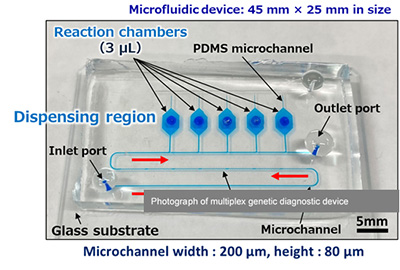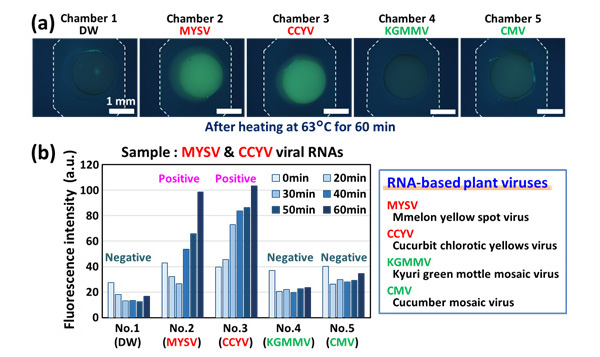
ここからコンテンツです。

Microfluidic chip technology enables rapid multiplex diagnosis of plant viral diseases
Early detection of crop disease at the genetic level, and protection of food safety. By Takayuki Shibata
A research team composed of Professor Takayuki Shibata and his colleagues at the Department of Mechanical Engineering, Toyohashi University of Technology has applied a microfluidic chip technology to develop a multiplex genetic diagnostic device for the early detection and prevention of crop diseases. The group conducted a gene amplification experiment using four kinds of cucumber viruses on the palm-size diagnostic device, and successfully demonstrated that the rapid multiplex diagnosis can be performed within 1 hour of testing. This diagnostic device is a highly versatile technology that can be used for genetic diagnosis of disease or infection not only in crops, but also in humans, and across a wide range of industries such as the agriculture, livestock & fisheries industries, the food industry, and health/medical care.
In the context of increased food demand due to world population growth and decreased production due to abnormal weather, the "steady supply of safe and high quality agricultural, forest, and fishery products and food" has become a pressing issue common to all humankind in order to actualize a sustainable world (Sustainable Development Goals, SDGs). This research aims at developing a diagnostic technology to support the effective and stable production of high quality crops. By utilizing this technology, even regular agricultural producers without special knowledge or skills can easily and rapidly test for plant diseases and insect pests at their farms at the genetic level.
Loop-mediated isothermal amplification (LAMP) * is one of the methods for detecting target nucleic acids (DNA or RAN). This approach can amplify the targeted gene at a constant temperature (60–65℃ for 30 minutes to 1 hour) without expensive instrumentation for high-precision temperature control in PCR assays, which is the most commonly used genetic diagnosis technique. Therefore, the LAMP method has considerable potential for providing an easy-to-use diagnostic tool and enabling on-site diagnoses. However, with the conventional LAMP method, multiple-item viral diagnosis is complicated because of the amount of samples (target DNA or target RNA), reagents preparation, and gene amplification reactions required for the test. This process also requires specialized knowledge and skills.

Here, the research team has solved this problem by employing microfluidic chip technology. We have developed a polydimethylsiloxane (PDMS)-based microfluidic device for the multiplex genetic diagnosis of plant diseases by using semiconductor manufacturing technology. The fabricated multiplex genetic diagnostic device consists of an array of five reaction chambers (3 µL in volume) and a microchannel (200 µm in width and 80 µm in height which together form a connected network. The device is approximately 45 mm×25 mm in size (less than 1/3 the size of a standard business card). As a sample, an RNA sample containing viral RNA target extracted from diseased cucumber leaves collected at a farm was used. In the operating procedure for the multiplex LAMP assay, a mixture of sample and reagents were autonomously dispensed into the multiple reaction chambers, with just one operation for introducing the mixture into the inlet port of the device. Then, the device was heated in hot water (63℃ for 40 minutes to 1 hour), resulting in the specific amplification of targeted nucleic acids. As shown in the figure, two kinds of RNA viruses were successfully detected simultaneously on our diagnostic device. It should be noted that the device has the ability to simultaneously diagnose up to four different kinds of plant viral diseases.

(Fluorescence intensity increased only in reaction chambers No.2 and No.3 corresponding to target viruses)
The team now plans to develop a diagnostic device for enabling the simultaneous detection of a total of eight items, including four kinds of cucumber viral diseases and four kinds of insect pests, with the aim of putting the device to practical use. In principle, it is possible to freely customize the types of target viruses to meet individuals’ specific needs on our diagnostic device. Therefore, looking ahead to the "life with corona" era, we will provide a platform for the rapid multiplex diagnosis of human infectious diseases (such as the novel coronavirus and the influenza viruses). We will also realize rapid multiplex allergen testing in food production (seven specified raw material items: wheat, buckwheat, peanut, egg, milk, shrimp, and crab) as a tool for improving food safety.
This research was partially supported by "Knowledge Hub Aichi", Priority Research Project from Aichi Prefectural Government. Additionally, this work was conducted as a part of "the Cooperative Project for Innovative Research" (Microfluidic-based Genetic Diagnostic and Improving Technologies for Enhancing Food Safety), funded by Toyohashi University of Technology.
* LAMP is an isothermal gene amplification method developed by Eiken Chemical Co., Ltd. (http://loopamp.eiken.co.jp/e/lamp/). This is a technique to amplify a target DNA at a constant temperature (60 - 65℃) by using a set of four to six primers specially designed to recognize six to eight distinct regions on the target gene based on strand displacement reaction.
References
Daigo Natsuhara, Keisuke Takishita, Kisuke Tanaka, Azusa Kage, Ryoji Suzuki, Yuko Mizukami, Norikuni Saka, Moeto Nagai, and Takayuki Shibata, (2020) A Microfluidic Diagnostic Device Capable of Autonomous Sample Mixing and Dispensing for the Simultaneous Genetic Detection of Multiple Plant Viruses, Micromachines, 11(6), 540. DOI: 10.3390/mi11060540.
マイクロ流体チップテクノロジーを応用して植物ウイルス病の多項目同時迅速診断に成功
農作物の病害を遺伝子レベルで早期に発見し、食の安全・安心を守るBy 柴田 隆行
豊橋技術科学大学 機械工学系 柴田隆行教授らの研究グループは、マイクロ流体チップテクノロジーを応用し、農作物の病害の早期発見・予防を目的としたマルチプレックス遺伝子診断デバイスの開発を行いました。手のひらサイズの診断デバイス上で、キュウリの病害ウイルス4種類の遺伝子増幅実験を行い、検査時間1時間以内での多項目同時迅速診断が可能であることを実証しました。本診断デバイスは、農作物のウイルス病に限らず、ヒト感染症などを含む様々な分野(農業・畜産・水産業、食品産業、健康・医療など)での遺伝子診断に活用できる汎用性の高い技術です。
世界の人口増加による食料需要の増大や異常気象による生産減少を背景として、「安全・安心・高品質な農林水産物・食料の安定供給」は、持続可能な世界を実現するための人類共通の喫緊の課題(SDGs:Sustainable Development Goals(持続可能な開発目標))となっています。本研究では、品質のよい農作物を効率よく安定して生産するための支援技術として、専門知識やスキルをもたない一般の農業生産者でも、農場にて簡便・迅速に病害虫の検査を遺伝子レベルで行える診断技術の開発を目指しています。
遺伝子検出(増幅)技術の一つとして、LAMP(Loop-Mediated Isothermal Amplification)法* があります。本手法は、一定の温度(60~65℃、30分~1時間程度)で遺伝子増幅が行えることから、PCR検査(最も普及している遺伝子診断技術)のように高価な精密温度制御装置などを必要とせずに現場(オンサイト)でも実施ができる簡易な検定法です。しかし、従来のLAMP法では、複数項目のウイルス診断を行うためには、検査対象の数だけ検体(標的DNAまたは標的RNA)・試薬の調整と遺伝子増幅反応を行う煩雑さがあり、その作業には専門的な知識やスキルが必要となります。
今回、研究チームでは、マイクロ流体チップテクノロジーを応用し、この問題を解決しました。開発したマルチプレックス遺伝子診断デバイス(反応容器3µL×5個)は、半導体製造技術を応用し、シリコーン樹脂(PDMS)によって作製したサイズ45mm×25mm(名刺サイズの1/3以下)のマイクロ流体デバイス(流路幅200µm、流路高さ80µm)です。サンプルには、農場で採集したキュウリ罹病葉から抽出した検体(標的RNAを含む抽出液)を使用しました。検査手順は、診断デバイスの導入口から検体と試薬の混合液をマイクロ流路内に1回の作業で導入するだけで、複数の反応容器内に検体・試薬が自律的に均等に分注される仕組みとなっています。その後、デバイスを湯中にて加温(63℃、40分~1時間程度)することで、標的となるウイルス遺伝子の特異的な増幅が起こります。図に示す遺伝子診断結果の一例では、2種類のウイルスを1つの診断デバイス上で同時に検出することに成功しています。なお、本診断デバイスでは、計4種類の植物ウイルス病の同時診断が可能になっています。
今後は、本診断デバイスの実用化を目指して、キュウリの病害ウイルス4種類に加えて、害虫4種類の計8項目の同時診断が行えるデバイスの開発を行います。また、原理上、本診断デバイスでは、ニーズに応じて検査対象のウイルスの種類を自由自在にカスタマイズすることが可能です。このため、ウィズコロナ時代を見据えて、新型コロナウイルスおよびインフルエンザウイルスなどの複数種類のウイルス感染症の多項目同時迅速診断の実現を目指します。さらに、食物アレルギー物質(特定原材料7品目:小麦、そば、落花生、卵、牛乳、えび、かに)の多項目同時迅速診断へと応用展開し、食の安全・安心に資する技術の提供を目指します。
本研究は,「知の拠点あいち重点研究プロジェクトⅢ期」(農業ビッグデータ活用によるロボティックグリーンハウスの実現 / 代表:三浦 純 教授)の一環として行いました。また、豊橋技術科学大学「イノベーション協働研究プロジェクト」(マイクロ流体チップテクノロジーで食の安全を診る・操る/代表:柴田 隆行 教授)の支援を受けて実施しました。
* LAMP法は、栄研化学株式会社(http://www.loopamp.eiken.co.jp/lamp/)が開発した等温遺伝子増幅法です。標的となる遺伝子の6~8つの領域に対して4~6種類のプライマーを設定し、鎖置換反応を利用して一定温度(60~65℃)で遺伝子を増幅する技術です。
Researcher Profile

| Name | Takayuki Shibata |
|---|---|
| Affiliation | Department of Mechanical Engineering |
| Title | Professor |
| Fields of Research | Micro- and Nano-fabrication, MEMS, Micro TAS, Bio MEMS |
ここでコンテンツ終わりです。
